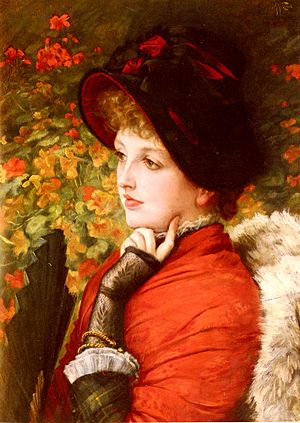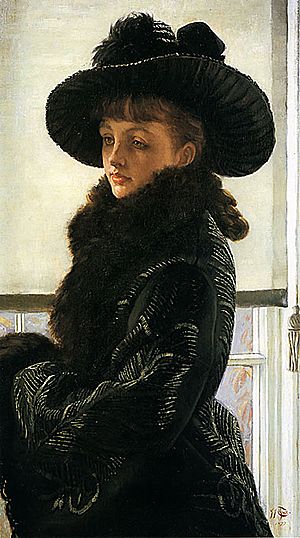Kathleen Newton facts for kids

Kathleen ("Kitty") Irene Ashburnham Newton (born Kelly; 1854–1882) was an Irish woman who became a special friend and model for the French artist James Tissot.
Contents
Early Life in India and England
Kathleen Irene Ashburnham Kelly was born on May 9, 1854, in Agra, India. Her father, Charles Frederick Ashburnham Kelly, worked for the East India Company. The Kelly family had strong Irish roots. Kathleen was often described as a "ravishing Irishwoman."
She was the youngest child of Charles and Flora Waterloo Kelly. After the Indian Rebellion in 1857-1858, Kathleen and her older sister Mary Pauline were sent to England for safety. Their uncle, Frederick Kelly, a doctor in London, looked after them. The girls were baptized in 1860. During the 1860s, both sisters attended Gumley House convent school in Isleworth, Middlesex.
Marriage and Family Life
At sixteen, Kathleen left school for an arranged marriage in India. Her eldest brother, George Lloyd Ashburnham Kelly, helped arrange her marriage to Dr. Isaac Newton, a respected army surgeon. On her journey to India, Kathleen met Captain Henry St Leger Bury Palliser.
Kathleen and Dr. Newton were married on January 3, 1871, in Hoshiarpur, Punjab. Soon after, Kathleen decided to return to England. She gave birth to her daughter, Muriel Violet Mary Newton (1871-1933), in December 1871. Her divorce from Dr. Newton was finalized in July 1872.
In March 1876, Kathleen had a son, Cecil George Newton (1876-1941), in London. She lived with her sister Mary Pauline and her family.
Life with Artist James Tissot
James Tissot was a successful French artist. He moved to London after the Franco-Prussian War in 1870-1871. By 1872, he bought a house in Grove End Road. From 1877 to 1882, Kathleen Newton became his most frequent model.
According to Kathleen's niece, Lilian Hervey, Tissot noticed Kathleen walking past his house. He asked if he could paint her portrait. During these sittings, they became very close. In 1877, Kathleen moved in with Tissot. Her children stayed with their aunt and cousins but often visited Tissot's house for fun.
Tissot and Kathleen lived together openly. They could not marry because Tissot was Catholic, and the Catholic Church did not recognize divorce. Their social circle included other artists and writers who accepted their relationship. These friends included James McNeill Whistler and Oscar Wilde. To the servants, Kathleen was known as 'Madame Tissot'. She called Tissot 'Jimmie', and he called her 'petite femme' (little woman).
An old friend of Tissot remembered him calling Kathleen "Kitty." He described her as "a ravishing Irishwoman," "delightful," and "distinguished." She was tall and slim, with beautiful blue eyes and long golden hair. Tissot created an etched portrait called Mavourneen. This name comes from the Irish phrase "mo mhuirnín," meaning "my dear one." It was also the title of a popular Irish song. This etching is considered one of Tissot's best works.
Tissot's paintings and prints from 1877-1881 often show Kathleen. Many pictures show her relaxing and reading in the garden. Around 1880-1881, Kathleen became ill with tuberculosis. Tissot painted her sitting outdoors, wrapped warmly, as fresh air was thought to help.
Her health worsened. Kathleen became a Roman Catholic on November 6, 1882. Three days later, on November 9, she passed away in Tissot's arms. The cause of death was tuberculosis. Kathleen's funeral was held on November 14, and she was buried in St Mary's Roman Catholic Cemetery in Kensal Green.
Kathleen Newton in Books
- Burnett, Frances Hodgson. Kathleen: A Charming Love Story, T. B. Peterson & Brothers (1878). This book tells the story of a painter who falls in love with a young woman named Kathleen.
- O'Reilly, Patricia. A Type of Beauty, the story of Kathleen Newton (1854–1882). Cape Press, 2010. ISBN: 978-0-9563632-0-6
- Paquette, Lucy, The Hammock: A novel based on the true story of French painter James Tissot. Lucille Paquette Zuercher, 2012. ISBN (ePub) 978-0-615-68267-9.
|



